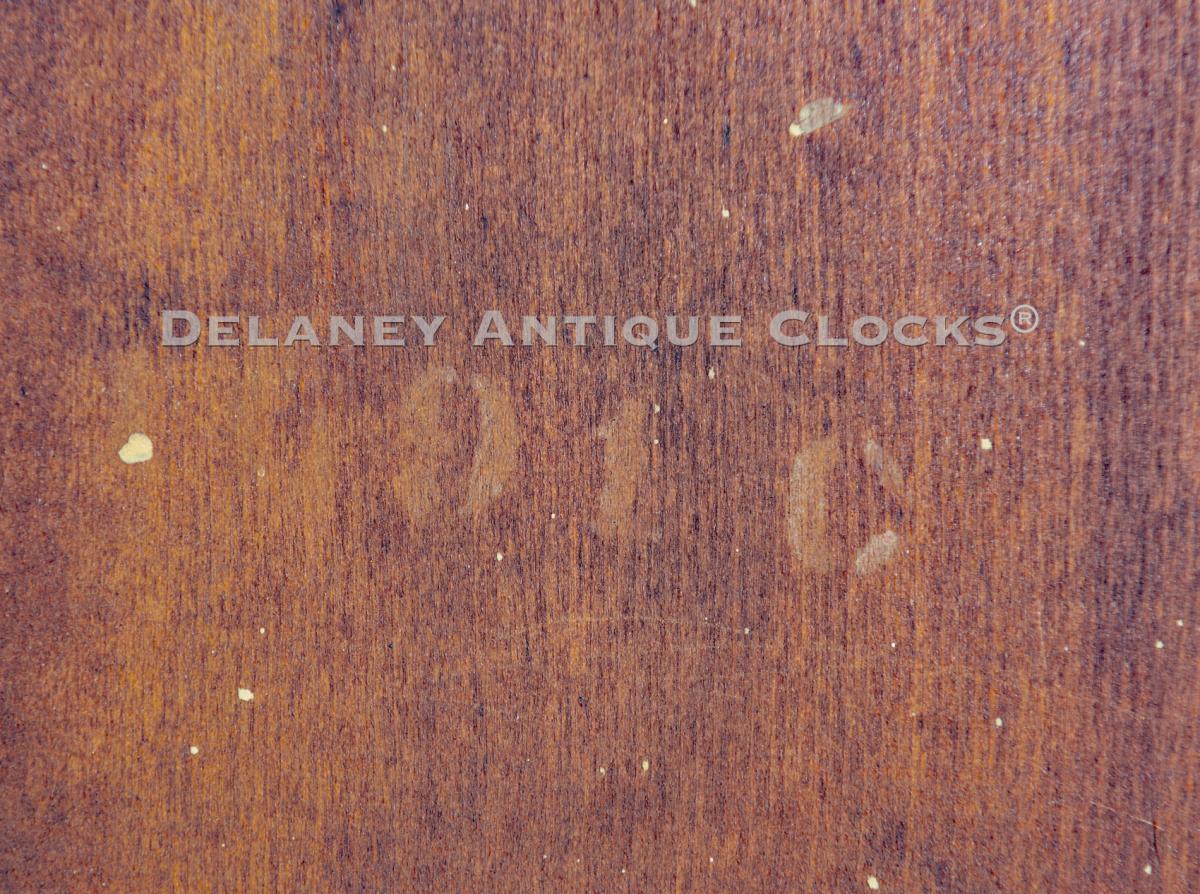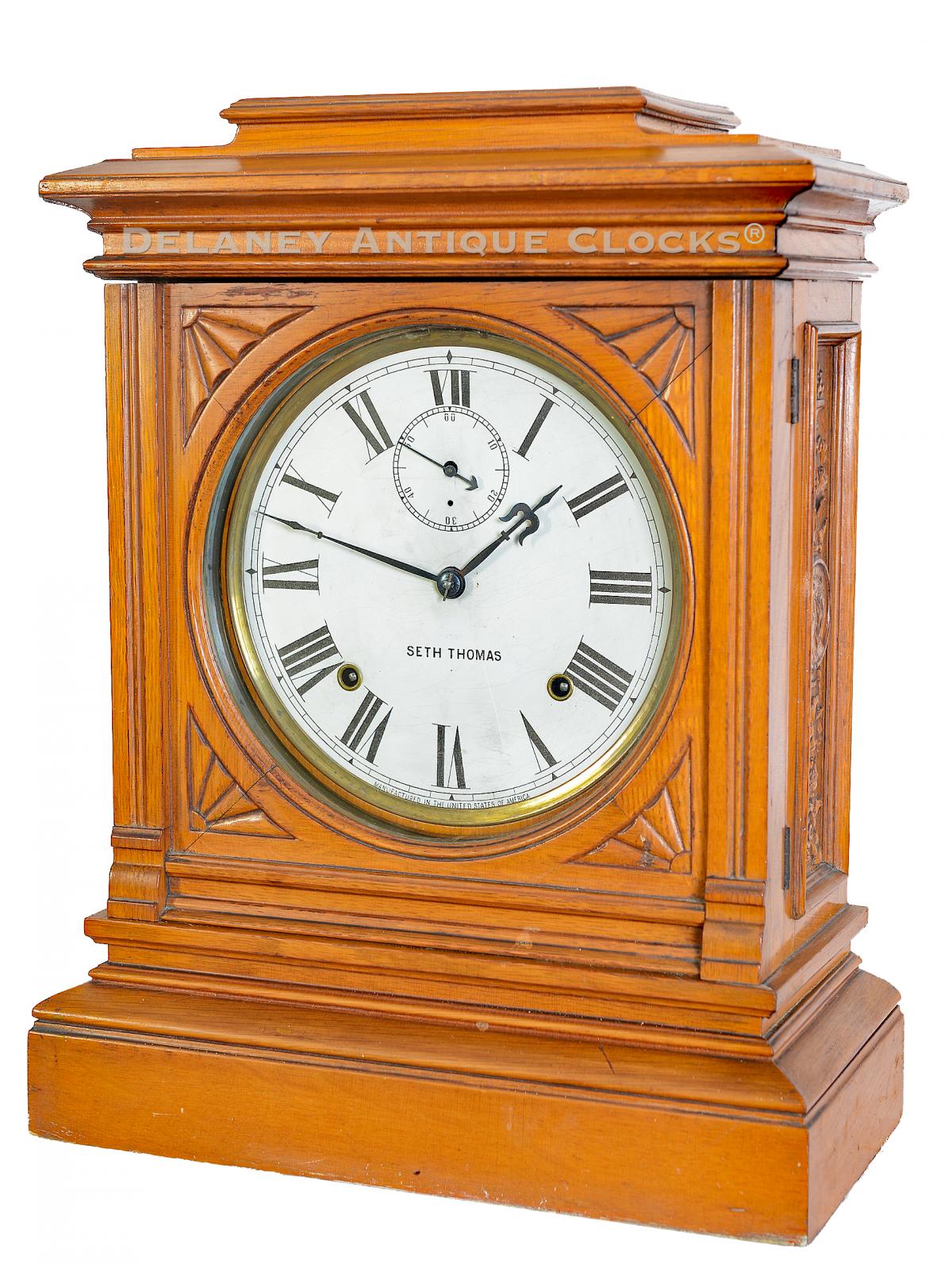The Seth Thomas Clock Company. The “Hotel.” 223090.
The Seth Thomas Clock Company made this fine mantel clock. It was offered in the 1900 catalog and called the “Hotel.” In today’s marketplace, it is a very difficult model to find. As a result, we have seen very few of these clocks for sale.
This example stands 18 inches tall, 14 inches wide, and just under 7 inches deep. The case is constructed in oak and retains a lovely golden color. (This model was also offered in walnut and mahogany.) The sides of the case feature decoratively carved panels. A depiction of a woman’s profile is centered in this panel as a medallion. The front door of the clock features carved quarter fans that frame the fitted glass opening to the dial. A brass trim ring is attached to the interior of the door and secures the glass in the circular opening. This door provides access to the painted dial.
The dial measures approximately 8 inches in diameter. The dial pan retains its original painted surface. The hours are indicated with Roman-style numerals, the minute ring is closed, and the Maker’s name is painted across the center. This dial also includes a subsidiary seconds display. The hands are better than most in that they feature an unusual shape.
The spring-driven eight-day, time-and-strike movement is constructed in brass and is one of Seth Thomas’ better quality examples. The front plate is die-stamped by the Maker and features a Geneva Stop winding mechanism. This movement is designed to run for eight days on a full wind and to strike each hour on a wire gong mounted inside the case. This wire gong is advertised in the catalog as a Cathedral Bell and produces a beautiful sound. The bell stand is die-stamped with a patent date. The pendulum hangs from the movement’s cast iron mounting bracket. The rod is made of wood, and the lead bob is covered in a decoratively engraved brass cover that is finished in nickel.
The backboard of this clock is stenciled with Seth Thomas’s date code. The code reads, “1091C.” This indicated that it was made in March of 1901.
This example is in very good condition and is ready to enjoy.
Inventory number 223090.
Seth Thomas was born in Wolcott, Connecticut, in 1785. He was apprenticed as a carpenter and joiner and worked building houses and barns. He started in the clock business in 1807, working for clockmaker Eli Terry. Thomas formed a clock-making partnership in Plymouth, Connecticut, with Eli Terry and Silas Hoadley as Terry, Thomas & Hoadley. In 1810, he bought Terry's clock business, making tall clocks with wooden movements. Seth chose to sell his shares in the partnership in 1812, moving in 1813 to Plymouth Hollow, Connecticut, where he set up a factory to make metal-movement clocks. In 1817, he added shelf and mantel clocks. By the mid-1840s, He successfully transitioned to brass movements and expanded his operations by building a brass rolling mill and a cotton factory. In 1853, He incorporated the business but continued to be the majority shareholder. This clock business expanded until it became one of the "BIG Seven" in Connecticut. Their product line had offerings that competed at every price point, from kitchen clocks to precision regulators. Seth Thomas died in 1859. The community of Plymouth Hollow so revered him that they changed the name on July 6, 1875, to Thomaston in his honor. After his death, his son, Aaron, took over the company's leadership. Aaron is credited with increasing the business by adding a number of new case styles and improving production methods. The company went out of business in the 1980s.




















